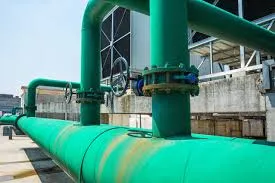fiberglass flange
Understanding Fiberglass Flanges Applications, Benefits, and Considerations
Fiberglass flanges are integral components in various industries, especially in applications that demand resilience to corrosion and temperature extremes. As materials increasingly pivot towards sustainability and durability, fiberglass, known for its impressive strength-to-weight ratio and chemical resistance, has gained significant traction in many fields. This article delves into the nature of fiberglass flanges, their applications, benefits, and important considerations when opting for this solution.
What Are Fiberglass Flanges?
Flanges are mechanical components used to connect two sections of pipe or a pipe to a valve, pump, or other equipment. Essentially, they provide a means for assembly and disassembly while ensuring a tight seal. Fiberglass flanges are composed of composite materials, predominantly fiberglass reinforced plastic (FRP). This composite material consists of a polymer matrix reinforced with glass fibers, offering enhanced strength compared to traditional materials like carbon steel or aluminum.
Applications of Fiberglass Flanges
1. Chemical Processing Plants The chemical industry often employs fiberglass flanges because they resist corrosion caused by aggressive chemicals. This property extends the lifespan of piping systems and reduces maintenance needs.
2. Water Treatment Facilities In water and wastewater treatment plants, fiberglass flanges are used due to their non-reactive nature. They help prevent contamination and ensure that the water remains safe for public use.
3. Oil and Gas Industry Fiberglass flanges are increasingly utilized in pipelines transporting corrosive substances. They minimize the risk of leaks and failures, which are critical in maintaining safety and efficiency in operations.
4. Marine Applications The marine environment is notoriously harsh, with saltwater causing rapid corrosion to metallic components. Fiberglass flanges offer a reliable alternative, resisting the effects of erosion and cavitation in marine systems.
5. HVAC Systems In heating, ventilation, and air conditioning systems, fiberglass flanges are used as they can handle varying temperatures and provide excellent insulation properties.
Benefits of Using Fiberglass Flanges
- Corrosion Resistance One of the most significant advantages of fiberglass flanges is their resistance to corrosion, which translates to lower replacement costs and higher operational efficiency
.fiberglass flange

- Lightweight Design Fiberglass is significantly lighter than metal options. This characteristic simplifies transportation and installation, making it a preferred choice in industries that require frequent assembly and disassembly.
- Thermal Insulation Fiberglass naturally insulates against temperature fluctuations, making these flanges suitable for systems where temperature control is critical.
- Cost-Effectiveness While the initial investment in fiberglass flanges may be higher than that of metal flanges, their longevity and reduced maintenance requirements lead to cost savings over their service life.
- Environmental Sustainability The use of fiberglass in flanges aligns with the growing emphasis on sustainability. Fiberglass materials can often be recycled, contributing to more sustainable practices in manufacturing and disposal.
Considerations When Choosing Fiberglass Flanges
While fiberglass flanges present numerous benefits, there are considerations to keep in mind
1. Temperature Limitations While fiberglass can handle a range of temperatures, there are limits. It’s essential to verify that the specific fiberglass material is rated for the temperature conditions of your application.
2. Pressure Ratings Not all fiberglass flanges are designed to withstand high pressures. It’s crucial to ensure that the selected flange can meet the pressure requirements of the system in which it will be installed.
3. Manufacturing Standards Ensure that the fiberglass flanges are manufactured according to relevant industry standards, such as ASTM or ASME, to guarantee quality and reliability.
4. Installation Practices Proper installation is vital for maximizing the benefits of fiberglass flanges. Following manufacturer recommendations and best practices in assembly can prevent failure and extend the component's lifespan.
Conclusion
Fiberglass flanges are a robust and versatile choice for a wide range of applications, particularly in environments where resistance to corrosion, weight, and thermal properties are crucial. Their growing adoption across industries highlights their relevance in modern engineering and manufacturing solutions. When considering fiberglass flanges, weighing their benefits against application-specific requirements ensures that you achieve optimal performance and reliability.
Latest news
-
Oblate Tanks: Space-Saving, Durable Liquid Storage SolutionsNewsAug.27,2025
-
High-Performance Piping System Solutions for Industry & Commercial UseNewsAug.26,2025
-
Precision Fittings: Durable & Reliable Industrial & Plumbing SolutionsNewsAug.25,2025
-
Practical Steps: Unlock Success with Our Proven GuidesNewsAug.24,2025
-
Transport Tanks: Safe, Durable & Efficient Liquid HaulingNewsAug.23,2025
-
High-Quality Piping Systems for Efficient Flow & DurabilityNewsAug.22,2025











